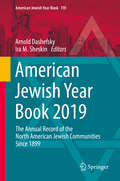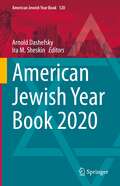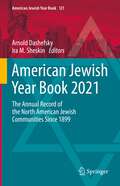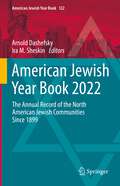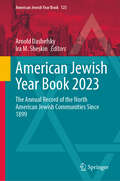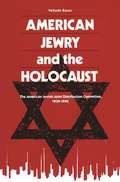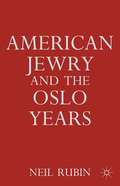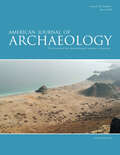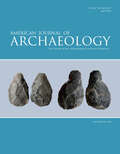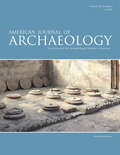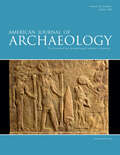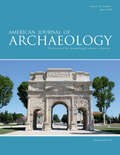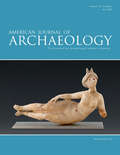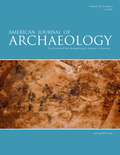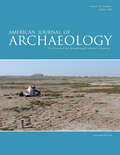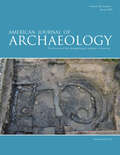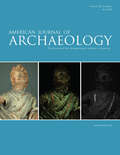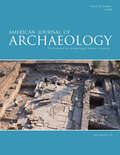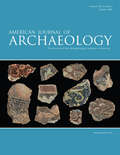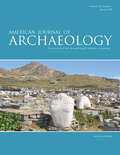- Table View
- List View
American Jewish Year Book 2019: The Annual Record of the North American Jewish Communities Since 1899 (American Jewish Year Book #119)
by Arnold Dashefsky Ira M. SheskinPart I of each volume will feature 5-7 major review chapters, including 2-3 long chapters reviewing topics of major concern to the American Jewish community written by top experts on each topic, review chapters on "National Affairs" and "Jewish Communal Affairs" and articles on the Jewish population of the United States and the World Jewish Population. Future major review chapters will include such topics as Jewish Education in America, American Jewish Philanthropy, Israel/Diaspora Relations, American Jewish Demography, American Jewish History, LGBT Issues in American Jewry, American Jews and National Elections, Orthodox Judaism in the US, Conservative Judaism in the US, Reform Judaism in the US, Jewish Involvement in the Labor Movement, Perspectives in American Jewish Sociology, Recent Trends in American Judaism, Impact of Feminism on American Jewish Life, American Jewish Museums, Anti-Semitism in America, and Inter-Religious Dialogue in America. Part II-V of each volume will continue the tradition of listing Jewish Federations, national Jewish organizations, Jewish periodicals, and obituaries. But to this list are added lists of Jewish Community Centers, Jewish Camps, Jewish Museums, Holocaust Museums, and Jewish honorees (both those honored through awards by Jewish organizations and by receiving honors, such as Presidential Medals of Freedom and Academy Awards, from the secular world). We expand the Year Book tradition of bringing academic research to the Jewish communal world by adding lists of academic journals, articles in academic journals on Jewish topics, Jewish websites, and books on American and Canadian Jews. Finally, we add a list of major events in the North American Jewish Community.
American Jewish Year Book 2020: The Annual Record of the North American Jewish Communities Since 1899 (American Jewish Year Book #120)
by Arnold Dashefsky Ira M. SheskinThe American Jewish Year Book, which spans three different centuries, is the annual record of the North American Jewish communities and provides insight into their major trends. Part I of the current volume contains the lead article: Chapter 1, “Pastrami, Verklempt, and Tshoot-spa: Non-Jews’ Use of Jewish Language in the US” by Sarah Bunin Benor. Following this chapter are three on domestic and international events, which analyze the year’s events as they affect American Jewish communal and political affairs. Three chapters analyze the demography and geography of the US, Canada, and world Jewish populations. Part II provides lists of Jewish institutions, including federations, community centers, social service agencies, national organizations, synagogues, Hillels, camps, museums, and Israeli consulates. The final chapters present national and local Jewish periodicals and broadcast media; academic resources, including Jewish Studies programs, books, journals, articles, websites, and research libraries; and lists of major events in the past year, Jewish honorees, and obituaries. While written mostly by academics, this volume conveys an accessible style, making it of interest to public officials, professional and lay leaders in the Jewish community, as well as the general public and academic researchers. The American Jewish Year Book has been a key resource for social scientists exploring comparative and historical data on Jewish population patterns. No less important, the Year Book serves organization leaders and policy makers as the source for valuable data on Jewish communities and as a basis for planning. Serious evidence-based articles regularly appear in the Year Book that focus on analyses and reviews of critical issues facing American Jews and their communities which are indispensable for scholars and community leaders.Calvin Goldscheider, Professor Emeritus of Sociology and Ungerleider Professor Emeritus of Judaic Studies, Brown University They have done it again. The American Jewish Year Book has produced yet another edition to add to its distinguished tradition of providing facts, figures and analyses of contemporary life in North America. Its well-researched and easily accessible essays offer the most up to date scrutiny of topics and challenges of importance to American Jewish life; to the American scene of which it is a part and to world Jewry. Whether one is an academic or professional member of the Jewish community (or just an interested reader of all things Jewish), there is not another more impressive and informative reading than the American Jewish Year Book. Debra Renee Kaufman, Professor Emerita and Matthews Distinguished University Professor, Northeastern University
American Jewish Year Book 2021: The Annual Record of the North American Jewish Communities Since 1899 (American Jewish Year Book #121)
by Arnold Dashefsky Ira M. SheskinAcross three centuries, AJYB has provided insight into major trends. Part I of the current volume contains two chapters on Jewish Americans in 2020 by the Pew Research Center, including reactions from 16 prominent social scientists. Subsequent chapters analyze the development of Holocaust consciousness in America, recent domestic and international events as they affect the American Jewish community, and the demography and geography of the US, Canada, and world Jewish populations. Part II provides lists of Jewish institutions, including federations, community centers, social service agencies, national organizations, camps, museums, and Israeli consulates. The final chapters present lists of Jewish periodicals and broadcast media, Jewish Studies programs, books, journals, articles, websites, research libraries, and academic conferences and lists of major events in the past year, Jewish honorees, and obituaries. This volume employs an accessible style, making it of interest to public officials, Jewish professional and lay leaders, as well as the general public and academic researchers.For more than 120 years the American Jewish Year Book has served as an indispensable resource for scholars, clergy, and lay leaders, providing crucial, detailed insights into demographic shifts and sociological trends in the North American Jewish community. The latest edition continues to fulfill these important needs with essential articles on the landmark Pew Report and the impact of the Holocaust in the American Jewish community and American in general. This is a must-have volume for any serious student of the contemporary Jewish world.Jeffrey Shoulson, Senior Vice Provost for Academic Affairs, Professor of Literatures, Cultures, and Languages, and English, Director Emeritus Center for Judaic Studies and Contemporary Jewish Life, University of ConnecticutThe American Jewish Year Book is a critical snapshot of Jews and Jewish Studies in the United States in a particular year, and a valuable resource for scholars studying the changes in Jewish communities and Jewish Studies in the United States (and beyond!) over time. The AJYB highlights major publications and data that are consistently used in research, and its scholarly essays contextualize the information in an easily readable context. The lists of important institutions and organizations are invaluable for someone interested in the broader Jewish experience (or, at the most practical, a Jewish organization in their neighborhood!).Michelle Margolis Chesner, Norman E. Alexander Librarian for Jewish Studies, Columbia University
American Jewish Year Book 2022: The Annual Record of the North American Jewish Communities Since 1899 (American Jewish Year Book #122)
by Arnold Dashefsky Ira M. SheskinAcross three different centuries, the American Jewish Year Book has provided insight into major trends among Jews primarily in North America. Part I of the current volume contains two chapters: One is a critical assessment of the major American Jewish Population Surveys over the past fifty years (1970-2020). The second chapter is an assessment of the media coverage of Israel in the American Press. Subsequent chapters address recent domestic and international events as they affect the American Jewish community, and the demography and geography of the US, Canada, and World Jewish populations. Part II provides lists of Jewish institutions, including federations, community centers, social service agencies, national organizations, camps, museums, and Israeli consulates. The final chapters present lists of Jewish periodicals and broadcast media, Jewish Studies programs, books, journals, articles, websites, research libraries, and academic conferences as well as lists of major events in the past year, Jewish honorees, and obituaries. This volume employs an accessible style, making it of interest to public officials, Jewish professional and lay leaders, as well as the general public and academic researchers.The American Jewish Year Book is a tremendously useful resource for scholars, Jewish community professionals, pundits, clergy, and policy makers. For over a century, it has offered comprehensive insight into North American Jewish demography, sociology, and culture. It remains a vital source for comprehending the complexities of American and Canadian Jewish life.Robin Judd, Associate Professor of History and Director of the Hoffman Program for Leaders and Leadership in History, The Ohio State UniversityThe American Jewish Year Book is the first draft of history, documenting the trends and topics of interest for such an organized community. Looking through the 100+ volumes, we can track how discussions have changed over time, which concerns have returned, and how we arrived at the current point in time. It is a valuable tool for anyone interested in trends in American Jewish life.David Manchester, Director of the Berman Jewish DataBank and Director of Community Data and Research Development at The Jewish Federations of North America
American Jewish Year Book 2023: The Annual Record of the North American Jewish Communities Since 1899 (American Jewish Year Book #123)
by Arnold Dashefsky Ira M. SheskinAcross three centuries, AJYB has provided insight into major trends. Part I of the current volume contains eight chapters: The first lead chapter includes an Audit of Antisemitic Incidents in 2023 produced by the ADL, and the second chapter examines Denominational Identity and Jewish Engagement. Subsequent chapters analyze recent domestic and international events as they affect the American Jewish community, major events in the past year, and the demography and geography of the US, Canada, and World Jewish populations. Part II contains nine chapters: lists of local Jewish organizations; Jewish museums, and Holocaust museums and monuments; overnight camps; national Jewish organizations; Jewish press; Jewish academic programs; Jewish academic resources; Jewish honorees; and Jewish obituaries. This volume employs an accessible style, making it of interest to public officials, Jewish professional and lay leaders, as well as the general public and academic researchers. For more than a century, the American Jewish Year Book has served as an indispensable compendium of Jewish demographic trends, research and data. It is considered a must-read for data scientists, demographers, community leaders or anyone interested in the trends that make up the lifeblood of the Jewish experience in America. We are proud of our contributions to this essential resource. Jonathan A. Greenblatt, CEO and National Director of ADL (the Anti-Defamation League) The American Jewish Year Book is a unique resource of tremendous value to anyone interested in global Jewish life. It is critical for people today, and it will be for those who come after us. Its lists capture not only critical information about key aspects of Jewish communal life, but provide the opportunity for reflection, comparison, and analysis with other religious and ethnic communities. Riv-Ellen Prell, Professor Emerita, American Studies and the Center for Jewish Studies, University of Minnesota
American Jewry
by Eli LederhendlerUnderstanding the history of Jews in America requires a synthesis of over 350 years of documents, social data, literature and journalism, architecture, oratory, and debate, and each time that history is observed, new questions are raised and new perspectives found. This book presents a readable account of that history, with an emphasis on migration patterns, social and religious life, and political and economic affairs. It explains the long-range development of American Jewry as the product of 'many new beginnings' more than a direct evolution leading from early colonial experiments to latter-day social patterns. This book also shows that not all of American Jewish history has occurred on American soil, arguing that Jews, more than most other Americans, persist in assigning crucial importance to international issues. This approach provides a fresh perspective that can open up the practice of minority-history writing, so that the very concepts of minority and majority should not be taken for granted.
American Jewry and the Holocaust: The American Jewish Joint Distribution Committee, 1939-1945
by Yehuda BauerIn this volume Yehudi Bauer describes the efforts made to aid European victims of World War II by the New York-based American Jewish Joint Distribution Committee, American Jewry's chief representative abroad. Drawing on the mass of unpublished material in the JDC archives and other repositories, as well as on his thorough knowledge of recent and continuing research into the Holocaust, he focuses alternately on the personalities and institutional decisions in New York and their effects on the JDC workers and their rescue efforts in Europe. He balances personal stories with a country-by-country account of the fate of Jews through ought the war years: the grim statistics of millions deported and killed are set in the context of the hopes and frustrations of the heroic individuals and small groups who actively worked to prevent the Nazis' Final Solution. This study is essential reading for anyone who seeks to understand the American Jewish response to European events from 1939 to 1945. Bauer confronts the tremendous moral and historical questions arising from JDC's activities. How great was the danger? Who should be saved first? Was it justified to use illegal or extralegal means? What country would accept Jewish refugees? His analysis also raises an issue which perhaps can never be answered: could American Jews have done more if they had grasped the reality of the Holocaust?
American Jewry and the Oslo Years
by Neil RubinThe Oslo Process of September 1993 to January 2001 ultimately brought about a permanent break in American Judaism's traditional wall-to-wall support for any Israeli government. Drawing on extensive new sources, Rubin analyzes what this meant for the American and Israeli Jewish communities--critical constituencies in past and future negotiations.
American Jews and America's Game: Voices of a Growing Legacy in Baseball
by Larry Ruttman Dr Martin Abramowitz Allan H SeligMost fans don’t know how far the Jewish presence in baseball extends beyond a few famous players such as Greenberg, Rosen, Koufax, Holtzman, Green, Ausmus, Youkilis, Braun, and Kinsler. In fact, that presence extends to the baseball commissioner Bud Selig, labor leaders Marvin Miller and Don Fehr, owners Jerry Reinsdorf and Stuart Sternberg, officials Theo Epstein and Mark Shapiro, sportswriters Murray Chass, Ross Newhan, Ira Berkow, and Roger Kahn, and even famous Jewish baseball fans like Alan Dershowitz and Barney Frank. The life stories of these and many others, on and off the field, have been compiled from nearly fifty in-depth interviews and arranged by decade in this edifying and entertaining work of oral and cultural history. In American Jews and America’s Game each person talks about growing up Jewish and dealing with Jewish identity, assimilation, intermarriage, future viability, religious observance, anti-Semitism, and Israel. Each tells about being in the midst of the colorful pantheon of players who, over the past seventy-five years or more, have made baseball what it is. Their stories tell, as no previous book has, the history of the larger-than-life role of Jews in America’s pastime.
American Jezebel: The Uncommon Life of Anne Hutchinson, the Woman Who Defied the Puritans
by Eve LaPlanteIn 1637, Anne Hutchinson, a forty-six-year-old midwife who was pregnant with her sixteenth child, stood before forty male judges of the Massachusetts General Court, charged with heresy and sedition. In a time when women could not vote, hold public office, or teach outside the home, the charismatic Hutchinson wielded remarkable political power. Her unconventional ideas had attracted a following of prominent citizens eager for social reform. Hutchinson defended herself brilliantly, but the judges, faced with a perceived threat to public order, banished her for behaving in a manner "not comely for [her] sex."Written by one of Hutchinson's direct descendants, American Jezebel brings both balance and perspective to Hutchinson's story. It captures this American heroine's life in all its complexity, presenting her not as a religious fanatic, a cardboard feminist, or a raging crank—as some have portrayed her—but as a flesh-and-blood wife, mother, theologian, and political leader. The book narrates her dramatic expulsion from Massachusetts, after which her judges, still threatened by her challenges, promptly built Harvard College to enforce religious and social orthodoxies—making her the mid-wife to the nation's first college. In exile, she settled Rhode Island, becoming the only woman ever to co-found an American colony.The seeds of the American struggle for women's and human rights can be found in the story of this one woman's courageous life. American Jezebel illuminates the origins of our modern concepts of religious freedom, equal rights, and free speech, and showcases an extraordinary woman whose achievements are astonishing by the standards of any era.
American Jihad
by Steven EmersonThe United States government is actively monitoring terrorist cells affiliated with Osama bin Laden's al Qaeda network in eleven cities, from Florida to Boston to Denver to Houston. But al Qaeda is hardly our only threat. Hamas, formed in 1987, was run by top Palestinian officials in America from its earliest days, and has tentacles in Texas, California, New Jersey, Virginia, and Illinois. The University of South Florida was infiltrated by the infamous organization known as Palestinian Islamic Jihad -- one of its faculty members even left the country to take that group's top leadership role after his predecessor was assassinated. Hizballah has been tied to cells in North Carolina and Michigan, from which it drew funds and attempted to procure military equipment. In short, September 11, 2001, was hardly an isolated or unpredictable event. The United States has become home to hundreds and probably thousands of terrorists, and it has become a central node in their international networks. Steven Emerson, hailed as "the nation's leading expert on Islamist terrorism," has been working full-time since 1993 to track the spread of terrorist networks to our shores, even at great personal risk. In 1995, not long after the release of his PBS documentary "Jihad in America," he was informed by federal officials that a South African Islamist death squad had been dispatched after him, and told that he should leave his home immediately. Since then he has not maintained a home address, though he has continued to write and testify under his own name. With the help of a staff of researchers he has followed the terrorists' monetary sources, monitored their attacks and plans, exposed their ties to charitable foundations, and assisted a variety of government agencies in the battle against them. He has obtained videotaped evidence of terrorist training camps and conferences, and tracked the international connections of American operatives to over a dozen organizations. In American Jihad Emerson reveals the full story that only he knows. This is a frightening and crucial book for anyone who needs to understand the threat within our borders.
American Journal of Archaeology, volume 126 number 1 (January 2022)
by American Journal of ArchaeologyThis is volume 126 issue 1 of American Journal of Archaeology. The American Journal of Archaeology, the journal of the Archaeological Institute of America, was founded in 1885 and is one of the world's most distinguished and widely distributed peer-reviewed archaeological journals. The AJA reaches more than 40 countries and approximately 700 universities, learned societies, departments of antiquities, and museums. The AJA publishes original research on the diverse peoples and material cultures of the Mediterranean and related areas, including North Africa (with Egypt and Sudan), Western Asia (with the Caucasus), and Europe, from prehistory through late antiquity.
American Journal of Archaeology, volume 126 number 2 (April 2022)
by American Journal of ArchaeologyThis is volume 126 issue 2 of American Journal of Archaeology. The American Journal of Archaeology, the journal of the Archaeological Institute of America, was founded in 1885 and is one of the world's most distinguished and widely distributed peer-reviewed archaeological journals. The AJA reaches more than 40 countries and approximately 700 universities, learned societies, departments of antiquities, and museums. The AJA publishes original research on the diverse peoples and material cultures of the Mediterranean and related areas, including North Africa (with Egypt and Sudan), Western Asia (with the Caucasus), and Europe, from prehistory through late antiquity.
American Journal of Archaeology, volume 126 number 3 (July 2022)
by American Journal of ArchaeologyThis is volume 126 issue 3 of American Journal of Archaeology. The American Journal of Archaeology, the journal of the Archaeological Institute of America, was founded in 1885 and is one of the world's most distinguished and widely distributed peer-reviewed archaeological journals. The AJA reaches more than 40 countries and approximately 700 universities, learned societies, departments of antiquities, and museums. The AJA publishes original research on the diverse peoples and material cultures of the Mediterranean and related areas, including North Africa (with Egypt and Sudan), Western Asia (with the Caucasus), and Europe, from prehistory through late antiquity.
American Journal of Archaeology, volume 126 number 4 (October 2022)
by American Journal of ArchaeologyThis is volume 126 issue 4 of American Journal of Archaeology. The American Journal of Archaeology, the journal of the Archaeological Institute of America, was founded in 1885 and is one of the world's most distinguished and widely distributed peer-reviewed archaeological journals. The AJA reaches more than 40 countries and approximately 700 universities, learned societies, departments of antiquities, and museums. The AJA publishes original research on the diverse peoples and material cultures of the Mediterranean and related areas, including North Africa (with Egypt and Sudan), Western Asia (with the Caucasus), and Europe, from prehistory through late antiquity.
American Journal of Archaeology, volume 127 number 1 (January 2023)
by American Journal of ArchaeologyThis is volume 127 issue 1 of American Journal of Archaeology. The American Journal of Archaeology, the journal of the Archaeological Institute of America, was founded in 1885 and is one of the world's most distinguished and widely distributed peer-reviewed archaeological journals. The AJA reaches more than 40 countries and approximately 700 universities, learned societies, departments of antiquities, and museums. The AJA publishes original research on the diverse peoples and material cultures of the Mediterranean and related areas, including North Africa (with Egypt and Sudan), Western Asia (with the Caucasus), and Europe, from prehistory through late antiquity.
American Journal of Archaeology, volume 127 number 2 (April 2023)
by American Journal of ArchaeologyThis is volume 127 issue 2 of American Journal of Archaeology. The American Journal of Archaeology, the journal of the Archaeological Institute of America, was founded in 1885 and is one of the world's most distinguished and widely distributed peer-reviewed archaeological journals. The AJA reaches more than 40 countries and approximately 700 universities, learned societies, departments of antiquities, and museums. The AJA publishes original research on the diverse peoples and material cultures of the Mediterranean and related areas, including North Africa (with Egypt and Sudan), Western Asia (with the Caucasus), and Europe, from prehistory through late antiquity.
American Journal of Archaeology, volume 127 number 3 (July 2023)
by American Journal of ArchaeologyThis is volume 127 issue 3 of American Journal of Archaeology. The American Journal of Archaeology, the journal of the Archaeological Institute of America, was founded in 1885 and is one of the world's most distinguished and widely distributed peer-reviewed archaeological journals. The AJA reaches more than 40 countries and approximately 700 universities, learned societies, departments of antiquities, and museums. The AJA publishes original research on the diverse peoples and material cultures of the Mediterranean and related areas, including North Africa (with Egypt and Sudan), Western Asia (with the Caucasus), and Europe, from prehistory through late antiquity.
American Journal of Archaeology, volume 127 number 4 (October 2023)
by American Journal of ArchaeologyThis is volume 127 issue 4 of American Journal of Archaeology. The American Journal of Archaeology, the journal of the Archaeological Institute of America, was founded in 1885 and is one of the world's most distinguished and widely distributed peer-reviewed archaeological journals. The AJA reaches more than 40 countries and approximately 700 universities, learned societies, departments of antiquities, and museums. The AJA publishes original research on the diverse peoples and material cultures of the Mediterranean and related areas, including North Africa (with Egypt and Sudan), Western Asia (with the Caucasus), and Europe, from prehistory through late antiquity.
American Journal of Archaeology, volume 128 number 1 (January 2024)
by American Journal of ArchaeologyThis is volume 128 issue 1 of American Journal of Archaeology. The American Journal of Archaeology, the journal of the Archaeological Institute of America, was founded in 1885 and is one of the world's most distinguished and widely distributed peer-reviewed archaeological journals. The AJA reaches more than 40 countries and approximately 700 universities, learned societies, departments of antiquities, and museums. The AJA publishes original research on the diverse peoples and material cultures of the Mediterranean and related areas, including North Africa (with Egypt and Sudan), Western Asia (with the Caucasus), and Europe, from prehistory through late antiquity.
American Journal of Archaeology, volume 128 number 2 (April 2024)
by American Journal of ArchaeologyThis is volume 128 issue 2 of American Journal of Archaeology. The American Journal of Archaeology, the journal of the Archaeological Institute of America, was founded in 1885 and is one of the world's most distinguished and widely distributed peer-reviewed archaeological journals. The AJA reaches more than 40 countries and approximately 700 universities, learned societies, departments of antiquities, and museums. The AJA publishes original research on the diverse peoples and material cultures of the Mediterranean and related areas, including North Africa (with Egypt and Sudan), Western Asia (with the Caucasus), and Europe, from prehistory through late antiquity.
American Journal of Archaeology, volume 128 number 3 (July 2024)
by American Journal of ArchaeologyThis is volume 128 issue 3 of American Journal of Archaeology. The American Journal of Archaeology, the journal of the Archaeological Institute of America, was founded in 1885 and is one of the world's most distinguished and widely distributed peer-reviewed archaeological journals. The AJA reaches more than 40 countries and approximately 700 universities, learned societies, departments of antiquities, and museums. The AJA publishes original research on the diverse peoples and material cultures of the Mediterranean and related areas, including North Africa (with Egypt and Sudan), Western Asia (with the Caucasus), and Europe, from prehistory through late antiquity.
American Journal of Archaeology, volume 128 number 4 (October 2024)
by American Journal of ArchaeologyThis is volume 128 issue 4 of American Journal of Archaeology. The American Journal of Archaeology, the journal of the Archaeological Institute of America, was founded in 1885 and is one of the world's most distinguished and widely distributed peer-reviewed archaeological journals. The AJA reaches more than 40 countries and approximately 700 universities, learned societies, departments of antiquities, and museums. The AJA publishes original research on the diverse peoples and material cultures of the Mediterranean and related areas, including North Africa (with Egypt and Sudan), Western Asia (with the Caucasus), and Europe, from prehistory through late antiquity.
American Journal of Archaeology, volume 129 number 1 (January 2025)
by American Journal of ArchaeologyThis is volume 129 issue 1 of American Journal of Archaeology. The American Journal of Archaeology, the journal of the Archaeological Institute of America, was founded in 1885 and is one of the world's most distinguished and widely distributed peer-reviewed archaeological journals. The AJA reaches more than 40 countries and approximately 700 universities, learned societies, departments of antiquities, and museums. The AJA publishes original research on the diverse peoples and material cultures of the Mediterranean and related areas, including North Africa (with Egypt and Sudan), Western Asia (with the Caucasus), and Europe, from prehistory through late antiquity.
American Journal of Archaeology, volume 129 number 2 (April 2025)
by American Journal of ArchaeologyThis is volume 129 issue 2 of American Journal of Archaeology. The American Journal of Archaeology, the journal of the Archaeological Institute of America, was founded in 1885 and is one of the world's most distinguished and widely distributed peer-reviewed archaeological journals. The AJA reaches more than 40 countries and approximately 700 universities, learned societies, departments of antiquities, and museums. The AJA publishes original research on the diverse peoples and material cultures of the Mediterranean and related areas, including North Africa (with Egypt and Sudan), Western Asia (with the Caucasus), and Europe, from prehistory through late antiquity.
